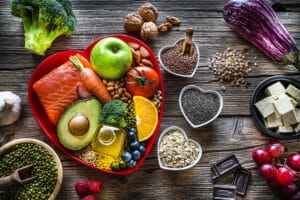Vitamin C may not be so humble after all. It is one of the safest and most effective nutrients, and it does much more than lessen the severity of the common cold. The preventive benefits of Vitamin C are broad based, and having optimal levels slashes risk of death. At this point the question is, “Are you getting enough of this mighty health defender?”
Vitamin C is needed for the synthesis of collagen, the structural foundation of skin, and a component of blood vessels, tendons, ligaments and bone. In the brain Vitamin C helps to synthesize the neurotransmitter norepinephrine, key to brain function and known to affect mood. Vitamin C is necessary for the synthesis of the coenzyme carnitine, essential for the transport of fat to the mitochondria where it is converted to energy. Vitamin C is instrumental in the metabolism of cholesterol to bile acids, a function with implications for blood cholesterol levels and the incidence of gallstones.
Vitamin C is a potent antioxidant that protects proteins, lipids (fats), carbohydrates and nucleic acids (DNA and RNA) from free radicals generated in the body and taken in by exposure to toxins and pollutants. It helps to recycle other antioxidants such as Vitamin E.
Are you getting enough Vitamin C?
Scurvy is the disease that results from severe Vitamin C deficiency. Scurvy is rarely seen in our world today, but other more subtle evidence abounds that many people are not getting enough Vitamin C. The daily recommended dietary allowance (RDA) for Vitamin C is 90 mg for grown men and women. This is enough to keep scurvy away, but it is far from optimal according to many health authorities. Nobel Prize winner and scientist in the fields of quantum chemistry and molecular biology, Dr. Linus Pauling, recommended and took daily doses of 10,000 mg or more of Vitamin C and wrote extensively on the subject. His popular book How to Live Longer and Feel Better was published shortly before his death at age 93.
Breakthrough research shows Vitamin C prevents damage from oxidized lipids
In 2005 researchers at the Linus Pauling Institute at Oregon State University (OSU) made a major discovery about the way Vitamin C functions in the human body. This breakthrough explained for the first time how Vitamin C plays a complex protective role in neutralizing toxic compounds formed by the oxidation of lipids and in preventing the genetic damage and inflammation they cause.
Through human tests, the OSU scientists identified extraordinarily high levels of Vitamin C conjugates in blood plasma that showed protective effects against toxic lipids. This discovery of a new class of Vitamin C metabolites is important in the understanding of Vitamin C and the metabolic role it plays. These metabolites appear to be a major pathway by which the body gets rid of the toxic byproducts of lipid metabolism that are likely related to cancer, heart disease, Alzheimer’s and autoimmune disorders.
Researchers believe the toxic byproducts of lipid metabolism are also very damaging to proteins. There is a protein in LDL cholesterol, considered “bad” cholesterol, that if damaged by toxic lipids can increase the chance of atherosclerotic lesions. The OSU researchers are continuing to studying the role of this newly understood reaction between Vitamin C and toxic lipids.
How else does Vitamin C protect?
Vitamin C is protective against many other disease states. It keeps the body looking and feeling younger, and mitigates in many processes that people have come to accept and write off as “just a part of getting old”.
Cardiovascular – The First National Health and Nutrition Examination Survey Epidemiologic Follow-up Study found that the risk of death from cardiovascular diseases was 42% lower in men and 25% lower in women who consumed more than 50 mg/day of dietary Vitamin C and regularly took Vitamin C supplements, getting a total intake of about 300 mg/day.
The Nurses’ Health Study which followed more than 85,000 women found that higher Vitamin C intake from diet plus supplements was associated with a 28% reduction in coronary heart disease. This finding held true only for those women supplementing their Vitamin C intake.
Analysis of nine prospective cohort studies, including more than 290,000 adults who were free of coronary heart disease at baseline and followed for an average of ten years, found that those who took more than 700 mg/day of supplemental Vitamin C had a 25% lower risk of coronary heart disease than those who did not take the supplements.
OSU has complied data from several studies and concluded that maximal reduction of coronary heart disease risk appears to require Vitamin C intakes of 400 mg/day or more.
Stroke – A prospective study following more than 2,000 Japanese for 20 years found the risk of stroke in those with the highest serum levels of Vitamin C was 29% lower than in those with the lowest serum levels of Vitamin C. The risk of stroke in those who consumed vegetables 6-7 days each week was 54% lower than in those who consumed vegetables 0-2 days of the week.
A ten year prospective study of 20,649 adults found that those in the top quartile of plasma vitamin C concentrations had a 42% lower risk of stroke compared to those in the lowest quartile.
Cancer – Many studies have shown that increased consumption of fruits and vegetables containing Vitamin C is associated with reduced risk for most types of cancer. Most have shown that higher intakes of Vitamin C are associated with decreased risk of cancers of the mouth, throat and vocal chords, esophagus, stomach, colon, rectum and lung. Studies finding significant cancer risk reductions found them in people consuming at least 80 to 110 mg of Vitamin C daily.
Two studies have even found that dietary Vitamin C intake is inversely associated with breast cancer risk. In the Nurses’ Health Study, premenopausal women with a family history of breast cancer who consumed an average of 205 mg/day of vitamin C from foods had a 63% lower risk of breast cancer than those who consumed an average of 70 mg/day.
Intravenous Vitamin C injections have repeatedly been shown to be effective against many kinds of cancerous tumors. The Japanese College of Intravenous Therapy has produced a video for people wishing to learn about large doses of Vitamin C. Links may be accessed below.
Cataracts – Cataracts development in the lenses of the eyes in many people as they age, resulting in poor vision and often in the need to have the natural lenses replaced by plastic intraocular lenses. Decreased Vitamin C levels have been associated with increased severity of cataracts in humans. Several studies have linked both dietary Vitamin C intake and increased blood levels of Vitamin C with decreased risk of cataracts.
Gout – Gout is a disease characterized by abnormally high blood level of uric acid that forms as crystals in joints resulting in inflammation and pain, and in the kidneys and urinary tract resulting in kidney stones. Although the tendency to develop gout is often inherited, dietary and lifestyle choices can prevent and alleviate gout.
A prospective study that followed a cohort of 46,994 men for 20 years found that total daily Vitamin C intake was inversely associated with risk of gout, with higher intakes being associated with greater risk reductions.
A randomized, double-blind, placebo-controlled trial in 184 nonsmokers found that Vitamin C supplementation (500 mg/day) for two months lowered serum concentrations of uric acid compared to placebo.
Lead toxicity- Vitamin C may facilitate lead detoxification. In a study of 19,568 people including 4,214 children from age six to 16, higher serum Vitamin C levels were associated with significantly lower blood lead levels.
A U.S. national survey of more than 10,000 adults also found that blood lead levels were inversely related to serum Vitamin C levels.
Immunity – One reason Vitamin C may protect against colds is its ability to affect several components of the immune system. Vitamin C has been shown to stimulate both the production and function of leukocytes (white blood cells), especially neutrophils, lymphocytes, and phagocytes.
Several studies have shown that supplemental Vitamin C increases serum levels of antibodies and complement proteins in guinea pigs, which like humans cannot synthesize Vitamin C.
How can you get enough Vitamin C?
The best source of Vitamin C is fresh raw fruits and vegetables which vary in their Vitamin C content. If you choose a variety of them to eat, five servings a day will average out to provide about 200 mg of Vitamin C. Fruits and vegetables especially high in Vitamin C are: guava, bell peppers, papaya, oranges and freshly squeezed orange juice, broccoli, kohlrabi, strawberries, grapefruit, cantaloupe, tomato juice, tangerines, potato baked and eaten with skin on, and cabbage.
Of all the nutrients, Vitamin C is the most easily destroyed. Oxygen and heat are its enemies. When foods are cooked, their Vitamin C content leaks out into the cooking water because Vitamin C is a water soluble vitamin.
Buy Vitamin C rich foods as close to the time you are planning to eat them as possible. Store them uncut in the refrigerator until you are ready to use. Prepare dishes with these foods just before serving, and cut them into large chunks to minimize oxygen exposure. Best cooking methods are light steaming and quick stir frying.
Cooking in a cast iron pan destroys Vitamin C.
It is apparent from the above noted studies and the work of Dr. Pauling that supplemental Vitamin C has great benefits. Here are some tips for buying it:
Most supplemental Vitamin C is synthetic ascorbic acid. This is true whether you buy it at Walmart or in a high priced health store. Ascorbic acid can raise the acidity levels of the body over time causing calcium to be depleted. Higher acidity is also associated with overall poorer health. Some Vitamin C in the form of ascorbic acid contains small amounts of natural nutrients such as rose hips or acerola, but it is still primarily the synthetic ascorbic acid form.
Look for a Vitamin C supplement that is completely natural, in the form of L ascorbate. Active C is an excellent choice. Because it is completely natural it is easily recognized, absorbed and utilized by the body. Active C is produced in an oxygen-free environment to assure full potency. This means its Vitamin C has not been exposed to oxygen until you open the bottle for the first time.



